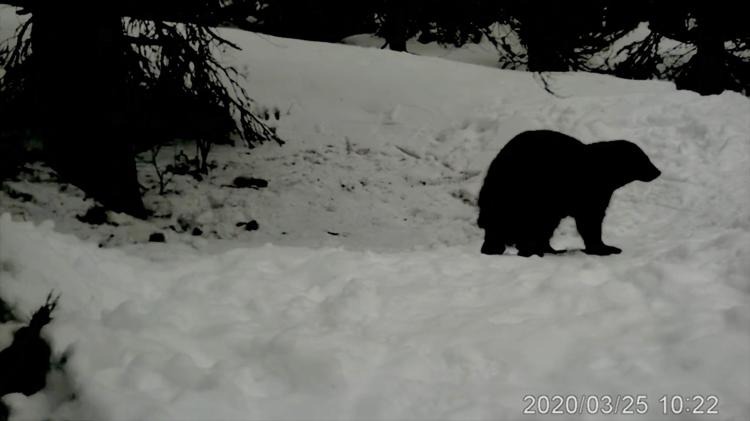A wolverine or two repeatedly visited trail cameras set on the west slope of the Tetons this winter. Courtesy Photo/BrushBuck Wildlife Tours.
NOTE: this article was originally published to TetonValleyNews.net on May 4, 2020. It was written by Julia Tellman.
Adam Lackner, the co-founder of local guiding outfit BrushBuck Wildlife Tours, has seen plenty of critters in his time leading trips in the nearby national parks, hunting, fishing, and tromping around in the backcountry, but this winter for the first time he observed one or possibly two wolverines on a company trail camera.
BrushBuck has several trail camera set-ups along the western slope of the Tetons. Each set includes three cameras–two video and one still–positioned to compensate for snow build-up through the winter, sometimes baited, and pointed to catch the most animal activity possible. Lackner’s father was a trapper and taught him techniques on where and how to set cameras for optimal viewing. Good locations include natural migration funnels, waterway corridors, and mountain springs. Some sites are easy to access with snowmachines or dirt bikes, while others necessitate foot, ski, or snowshoe travel.
Clients and locals enjoy watching the videos captured by the trail cameras, available to view at BrushBuck’s YouTube channel, called “Wildlife Window.”
Last fall Lackner and fellow guides Daniel Bradford and Clint Parkhill set their cameras in undisclosed locations in Teton Valley. (Lackner is choosing not to release the site information because too often people tamper with, remove, or damage the sets.)
He explained that setting the cameras provides an opportunity for BrushBuck guides, many of whom have scientific backgrounds, to get out in the woods and do some exploration, with the possibility of adding to regional wildlife data.
“The staff likes to see what’s out there. It’s right up their alley,” he said. “It keeps them engaged. Leading tours is more about talking, telling stories to visitors, whereas our guides want to go out in their free time and fish, float, go hunting, check the cams, and we encourage that. People want the most local guide they can get, and they naturally gravitate toward the guides who have that familiarity.”
Lackner said the best thing about game cameras is that it’s like Christmas every time you check them. “You never know what you’ll get.”
On actual Christmas Day in 2019, one camera caught a surprising visitor: a wolverine, the rarely-seen largest member of the weasel family. The wolverine lingered in the area of the set-up for a few days then moved on. But it was back in late January, hitting on another camera a couple miles away, although that might have been a different wolverine. In mid-March, the elusive animal “got all over our set,” Lackner said. The video shows the wolverine rubbing and marking in the area. It hit once more on April 13.
“It’s pretty nice to have that continuity with something so rare,” Lackner added.
It appears there might be two wolverines roving around the western slope; one, which Lackner suspects is a male, is very dark with two little white dots on the left side of its neck (this collar is generally how observers identify individuals). There may have been a smaller second wolverine, although it’s hard to prove. The really exciting news, Lackner said, is that the animal returned multiple times, meaning it might not be just passing through. Wolverines perambulate across huge territories and prefer high-altitude habitat with a deep snowpack.
“It could be a dispersing male that’s just looking to shack up with a female, but to get a pattern of consistent hits, maybe even to get a breeding population, that’s really something,” Lackner said. “That’s a whole different ball game.”
He hopes BrushBuck’s recordings can add to the accumulated knowledge of the nonprofit Wolverine Foundation, which promotes science-based management of the species, and the work of Idaho Fish & Game, which has cameras set up in Island Park.
“We live in a wild place,” Lackner said. “From Island Park, or even up to Bozeman, all the way down to Teton Pass, the drainages are all so wild. The west slope of the Tetons, in particular, touches the part of this region that has barely changed.”

